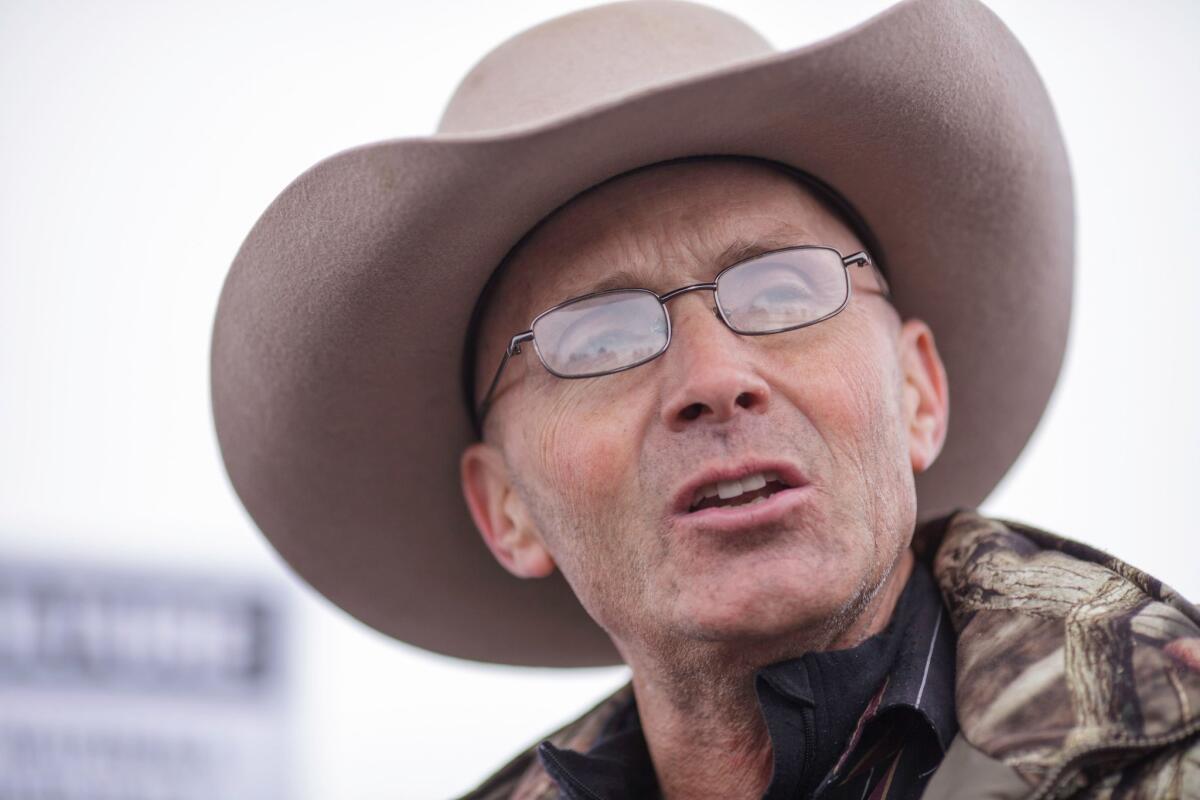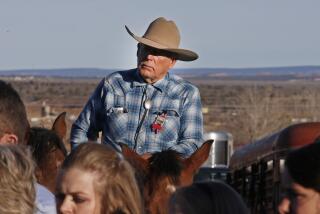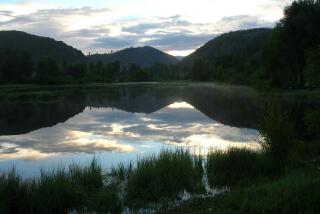Op-Ed: What did LaVoy Finicum die for?

LaVoy Finicum at the Malheur National Wildlife Refuge in Oregon in January.
The occupation of Malheur National Wildlife Refuge in Harney County, Ore., is mostly over. Four militants remain inside the refuge; 11 have been arrested and charged, including the Bundy brothers Ammon and Ryan. Only Robert “LaVoy” Finicum made good on his promise to die rather than submit to the federal government. But if “the tree of liberty is watered by the blood of patriots” — the militia movement’s favorite Jefferson quote — then Finicum’s death is exactly the sort of martyrdom that law enforcement hoped to avoid and didn’t. Now is a good time to ask: What exactly did he die for?
To “patriots” like Finicum and the Bundys, the movement to reclaim public lands from the federal government is a variation on America’s cowboys and Indians story, but in their version they’re the cowboys and the Indians. On the one hand, they position themselves as the descendants of men and women who first won the West, the settlers who originally built this country. On the other, they see themselves as the victims of a huge land grab, locals who have been forcefully dispossessed. That makes them both an oppressed minority and the conquering heroes of manifest destiny.
To understand this precarious and contradictory position — which sits at the radical edge of a larger, well-funded land-transfer, anti-environmental movement that seeks to privatize public property —- we have to go back to this nation’s original sin. When the United States took the West from its first inhabitants — by treaty, deception and force of arms — the government put forward a consistent legal, moral, and political principle to justify the seizure. It is much the same doctrine that Finicum preached around the West to ranchers groups; he called it “productive beneficial use.” Put simply: the land belongs to those who use it productively, those whose ranching, farming and stewardship benefit the land.
“I have created a right when I’m the first one in line,” Finicum told an audience of cattlemen at a property rights workshop in Piute County, Utah, in November. “As long as I use this for continuous beneficial use, I have it.” (According to the Salt Lake Tribune, eight ranchers who were at the November workshop signed letters withdrawing their “consent” to be governed by the BLM and the Forest Service in late January.)
Finicum’s claims are a crude version of something the English philosopher John Locke argued in his second political treatise.
Finicum’s claims are a crude version of something the English philosopher John Locke argued in his second political treatise (one of the formative components of Jefferson’s own philosophy). For Locke, property was a function of human labor. God “gave the world in common to all mankind,” as Locke put it, but He also commanded individual people “to labour,” and “to subdue the earth.” If a portion of “the world in common” were improved by an individual “for the benefit of life,” Locke reasoned, that individual had made it his personal property, “which another had no title to, nor could without injury take from him.”
------------
FOR THE RECORD, 4:40 p.m. Feb. 7: A previous version of this article said philosopher John Locke was Scottish. He is English.
------------
From this perspective, God-given land was only “common” until someone did something productive and beneficial with it; from then on, it was his or hers alone. Put more crudely: Use it or lose it.
When the United States pushed American Indians off the land, the justification was that Indians didn’t use the land productively or beneficially. This required a very narrow and self-interested definition of “productive” and “beneficial,” of course: White farmers and ranchers believed they improved the land with their labor, regarding Indians as animals, having no more right to the land than a bear or a bird.
In 1812, the General Land Office began overseeing the disposal of the lands the United States government was busily acquiring in the West. The Preemption Act of 1841 and the Homestead Act of 1862 supplied guidelines for the disposal; the former gave land to those who were already farming it and the latter to those who applied to settle it. But the underlying principle was the same: having taken the lands from the native peoples, the federal government was to be only a temporary steward of the land until it was given to a “productive beneficial” user.
Over the course of the 20th century, the federal government changed its position in response to environmental degradation, overcrowding, the need for multiple-users to co-exist and a general demand that the public have access to public land. The General Land Office became the Bureau of Land Management, and after a piecemeal succession of laws and amendments, Congress convened a commission to reformulate the nation’s public land law, from the top down.
The commission’s 1970 report — “One Third of the Nation’s Land” — argued that “most public lands would not serve the maximum public interest in private ownership” and urged the “reversal of the policy that the United States should dispose of ... public domain lands.” In 1976, Congress passed the Federal Land Policy and Management Act, repealing most of the old disposal laws and dictating that public lands would be “retained in Federal ownership in perpetuity,” except for special cases. Though the Bureau of Land Management leases the land for development and a variety of commercial uses, their official mandate is to keep the land open and accessible to all users, preserving it for the future.
The agrarian past is gone. The United States economy has not depended on farmers and ranchers for a very long time. Even LaVoy Finicum couldn’t make ends meet as a rancher in the 21st century; his primary source of income, according to Oregon Public Radio, was the payment his family received for fostering children.
In the end, Finicum didn’t die for the sake of liberty or the Constitution, but for an outdated, narrow and self-interested notion of how the West was won.
Aaron Bady is an editor at the New Inquiry. He lives in Oakland.
Follow the Opinion section on Twitter @latimesopinion and Facebook
More to Read
A cure for the common opinion
Get thought-provoking perspectives with our weekly newsletter.
You may occasionally receive promotional content from the Los Angeles Times.










